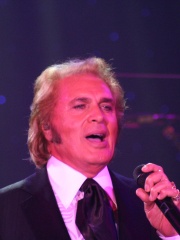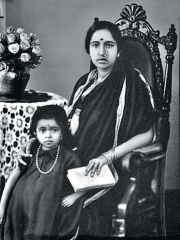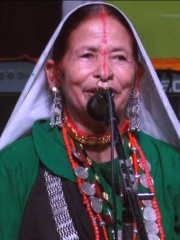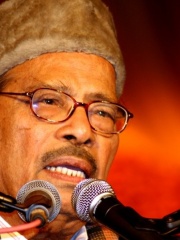







The Most Famous
SINGERS from India
Top 10
The following people are considered by Pantheon to be the top 10 most legendary Indian Singers of all time. This list of famous Indian Singers is sorted by HPI (Historical Popularity Index), a metric that aggregates information on a biography's online popularity. Visit the rankings page to view the entire list of Indian Singers.

1. Lata Mangeshkar (1929 - 2022)
With an HPI of 68.20, Lata Mangeshkar is the most famous Indian Singer. Her biography has been translated into 76 different languages on wikipedia.
Lata Mangeshkar (Hindi pronunciation: [ləˈt̪aː məŋˈɡeːʃkəɾ] ; born Hema Mangeshkar; 28 September 1929 – 6 February 2022) was an Indian playback singer and occasional music composer. She is considered to be one of the greatest and most influential singers of the Indian subcontinent. Her contribution to the Indian music industry in a career spanning eight decades gained her honorific titles such as the "Queen of Melody" and "Voice of the Millennium". Mangeshkar recorded songs in over thirty-six Indian languages and a few foreign languages, though primarily in Hindi, Bengali and Marathi. She received several accolades and honors throughout her career. In 1989, the Dadasaheb Phalke Award was bestowed on her by the Government of India. In 2001, in recognition of her contributions to the nation, she was awarded the Bharat Ratna, becoming only the second singer to receive India's highest civilian honour. In 2009, France made her an Officer of the National Order of the Legion of Honour, the country's highest civilian award. She was the recipient of three National Film Awards, 15 Bengal Film Journalists' Association Awards, four Filmfare Best Female Playback Awards, before declining further ones, two Filmfare Special Awards, the Filmfare Lifetime Achievement Award amongst others. In 1974, she became the first Indian playback singer to perform at the Royal Albert Hall in London, England. She appeared in the Guinness World Records as the most recorded artist in history before being replaced by her sister, Asha Bhosle.

2. Engelbert Humperdinck (b. 1936)
With an HPI of 67.16, Engelbert Humperdinck is the 2nd most famous Indian Singer. His biography has been translated into 45 different languages.
Arnold George Dorsey (born 2 May 1936), known professionally as Engelbert Humperdinck, is a British pop singer described by AllMusic as "one of the finest middle-of-the-road balladeers around". He achieved international prominence in 1967 with his recording of "Release Me". Humperdinck started as a performer in the late 1950s under the name "Gerry Dorsey", but found success after 1965 when he partnered with manager Gordon Mills, who advised him to adopt the name of German composer Engelbert Humperdinck as a stage name. His recordings of the ballads "Release Me" and "The Last Waltz" topped the UK Singles Chart in 1967, selling more than a million copies each. Humperdinck scored further major hits in rapid succession, including "There Goes My Everything" (1967), "Am I That Easy to Forget" (1968), and "A Man Without Love" (1968). He attained a large following, with some of his most devoted fans calling themselves "Humperdinckers". Two of his singles were among the best-selling of the 1960s in the UK. During the 1970s, Humperdinck had significant American chart successes with "After the Lovin'" (1976) and "This Moment in Time" (1979). He garnered a reputation as a concert performer and received renewed attention during the 1990s lounge revival with his recordings of "Lesbian Seagull" for the soundtrack of Beavis and Butt-Head Do America (1996) and a dance album (1998). The new millennium brought a range of musical projects, including the Grammy-nominated gospel album Always Hear the Harmony: The Gospel Sessions (2003) and the double album of duets Engelbert Calling (2014). Humperdinck represented the UK at the Eurovision Song Contest 2012 in Baku with the song "Love Will Set You Free", placing 25th out of 26. Humperdinck continues to record and tour, having sold more than 140 million records worldwide.

3. Mohammed Rafi (1924 - 1980)
With an HPI of 61.60, Mohammed Rafi is the 3rd most famous Indian Singer. His biography has been translated into 52 different languages.
Mohammed Rafi (24 December 1924 – 31 July 1980) was an Indian playback singer. He is considered to have been one of the greatest and most influential singers of the Indian subcontinent. Rafi was notable for his versatility and range of voice; his songs varied from fast, peppy numbers to patriotic songs, sad numbers to highly romantic songs, qawwalis to ghazals and bhajans to classical songs. He was known for his ability to mould his voice to the persona and style of the actor lip-syncing the song on screen in the movie. He received six Filmfare Awards and one National Film Award in India. In 1967, he was honored with the Padma Shri award by the Government of India. In 2001, Rafi was honoured with the "Best Singer of the Millennium" title by Hero Honda and Stardust magazine. In 2013, Rafi was voted for the Greatest Voice in Hindi Cinema in a CNN-IBN poll. He recorded songs for over a thousand Hindi films and in many Indian languages as well as some foreign languages, though primarily in Urdu and Punjabi, over which he had a strong command. He recorded as many as 7,000 songs throughout his career, spanning several languages such as Konkani, Assamese, Bhojpuri, Odia, Bengali, Marathi, Sindhi, Kannada, Gujarati, Tamil, Telugu, Magahi, Maithili, etc. Apart from Indian languages, he also sang in some foreign languages, including English, Persian, Arabic, Sinhala, Mauritian Creole, and Dutch.

4. Navneet Aditya Waiba (b. 0)
With an HPI of 60.15, Navneet Aditya Waiba is the 4th most famous Indian Singer. Her biography has been translated into 19 different languages.
Navneet Aditya Waiba is an Indian singer who primarily sings in Nepali-language and the daughter of the late Hira Devi Waiba, the pioneer of Nepali folk music. Navneet and brother Satya Aditya (producer/manager) maintain the essence of the folk music genre by producing authentic traditional Nepali folk songs using traditional musical instruments.

5. Kishore Kumar (1929 - 1987)
With an HPI of 60.05, Kishore Kumar is the 5th most famous Indian Singer. His biography has been translated into 43 different languages.
Kishore Kumar (born Abhas Kumar Ganguly; ; 4 August 1929 – 13 October 1987) was an Indian playback singer, musician and actor. He is widely regarded as one of the greatest, most influential and dynamic singers in the history of Indian music. Kumar was one of the most popular singers in the Indian subcontinent, notable for his yodelling and ability to sing songs in different voices. He used to sing in different genres but some of his rare compositions, considered classics, were lost in time. In 2013, Kumar was voted "The Most Popular Male Playback Singer" in a poll conducted by the Filmfare magazine. He was extremely popular in the Hindi film industry and Bengali film industry singing various songs for various actors. Besides Hindi and Bengali, he sang in many other Indian languages, including Marathi, Assamese, Gujarati, Kannada, Bhojpuri, Malayalam, Odia and Urdu. He also released a few non-film albums in multiple languages, especially in Bengali, which are noted as all-time classics. According to his brother and legendary actor Ashok Kumar, Kishore Kumar was successful as a singer because his "voice hits the mike, straight, at its most sensitive point". He won 8 Filmfare Award for Best Male Playback Singer out of 28 nominations and holds the record for winning and nominating the most Filmfare Awards in that category. He was awarded the Lata Mangeshkar Award by the Madhya Pradesh government in 1985. In 1997, the Madhya Pradesh Government initiated an award called the "Kishore Kumar Award" for contributions to Hindi cinema. In 2012, his unreleased last song sold for ₹15.6 lakh ($17,500 US) at the Osian's Cinefan Auction in New Delhi.

6. Asha Bhosle (b. 1933)
With an HPI of 60.04, Asha Bhosle is the 6th most famous Indian Singer. Her biography has been translated into 54 different languages.
Asha Bhosle (pronounced [ˈaːʃaː ˈbʱos(ə)le]; née Mangeshkar; born 8 September 1933) is an Indian playback singer, entrepreneur, actress and television personality who predominantly works in Indian cinema. Known for her versatility, she has been described in the media as one of the greatest and most influential singers in Hindi cinema. In her career spanning over eight decades she has recorded songs for films and albums in various Indian languages and received several accolades including two National Film Awards, four BFJA Awards, eighteen Maharashtra State Film Awards, nine Filmfare Awards including a Lifetime Achievement Award and a record seven Filmfare Awards for Best Female Playback Singer, in addition to two Grammy nominations. In 2000, she was honoured with the Dadasaheb Phalke Award, India's highest award in the field of cinema. In 2008, she was honoured by the Government of India with the Padma Vibhushan, the second-highest civilian honour of the country. The Guinness Book of World Records acknowledged her in 2011 as the most recorded artist in music history. Bhosle is the sister of playback singer Lata Mangeshkar and belongs to the prominent Mangeshkar family. Renowned for her soprano voice range and often credited for her versatility, Her work includes film music, pop, ghazals, bhajans, traditional Indian classical music, folk songs, qawwalis, and Rabindra Sangeet. Apart from Hindi, she has sung in over 20 Indian and foreign languages. In 2013, she made her debut as an actress in the film Mai, and received critical acclaim for her performance. In 2006, she stated that she has recorded over 12,000 songs in her career, a figure repeated by several other sources.

7. Kavita Krishnamurthy (b. 1958)
With an HPI of 59.74, Kavita Krishnamurthy is the 7th most famous Indian Singer. Her biography has been translated into 29 different languages.
Kavita Krishnamurthy (born as Sharada Krishnamurthy), is an Indian playback and classical singer. She has recorded 50,000 numerous songs in 45 various Indian languages including Hindi, Bengali, Kannada, Rajasthani, Bhojpuri, Telugu, Odia, Marathi, English, Urdu, Tamil, Malayalam, Gujarati, Nepali, Assamese, Konkani, Punjabi and other languages. She is the recipient of four Filmfare Best Female Playback Singer Awards (winning consecutively during 1995–1997), and the Padmashri which she received in 2005. She was awarded a Doctorate (Honoris Causa) for her contributions to Indian music by Bangalore-based Jain University in 2015. In 1999, she married noted violinist L. Subramaniam and resides in Bengaluru.

8. Kumar Sanu (b. 1957)
With an HPI of 59.73, Kumar Sanu is the 8th most famous Indian Singer. His biography has been translated into 29 different languages.
Kumar Sanu (born Kedarnath Bhattacharya on 20 October 1957 ) is an Indian playback singer who gained recognition in Hindi cinema during the 1990s. He is known for his melodious voice and prolific output, recording songs in multiple languages including Hindi, Bengali, Nepali, Marathi, Tamil, Telugu, Kannada, Malayalam, Gujarati, Punjabi, Bhojpuri and Odia. Sanu gained widespread recognition with the soundtrack of Aashiqui (1990), which featured him in nearly all of the male solo songs and established him as a leading playback singer of the period. He won the Filmfare Awards for Best Male Playback Singer for five consecutive years from 1990 to 1995, for films including Aashiqui (1990), Saajan (1991), Deewana (1992), Baazigar (1993) and 1942: A Love Story (1994). In 1993, Sanu entered the Guinness World Records for recording 28 songs in a single day. Several of his songs were included in the BBC "Top 40 Bollywood soundtracks of all time". He has also appeared as a mentor and judge on television music reality shows. In recognition of his contributions to Indian music, Sanu was awarded the Padma Shri by the Government of India in 2009.

9. Gangubai Hangal (1913 - 2009)
With an HPI of 59.52, Gangubai Hangal is the 9th most famous Indian Singer. Her biography has been translated into 23 different languages.
Gangubai Hangal (5 March 1913 – 21 July 2009) was an Indian singer of the khayal genre of Hindustani classical music from Karnataka, who was known for her deep and powerful voice. Hangal belonged to the Kirana gharana. She was awarded the Padma Vibhushan, India's second highest civilian honour in 2002 and Sangeet Natak Akademi Fellowship, the highest award of Sangeet Natak Akademi, India's National Academy for Music and Performing Arts in 1996.

10. M. S. Subbulakshmi (1916 - 2004)
With an HPI of 58.51, M. S. Subbulakshmi is the 10th most famous Indian Singer. Her biography has been translated into 32 different languages.
Madurai Shanmukhavadivu Subbulakshmi (16 September 1916 – 11 December 2004) was an Indian Carnatic singer. She was the first musician ever to be awarded the Bharat Ratna, India's highest civilian honour and also the first Indian musician to receive the Ramon Magsaysay award in 1974. She was the first Indian to perform at the United Nations General Assembly in 1966.
People
Pantheon has 100 people classified as Indian singers born between 1873 and 1999. Of these 100, 65 (65.00%) of them are still alive today. The most famous living Indian singers include Engelbert Humperdinck, Navneet Aditya Waiba, and Asha Bhosle. The most famous deceased Indian singers include Lata Mangeshkar, Mohammed Rafi, and Kishore Kumar. As of April 2024, 20 new Indian singers have been added to Pantheon including Prabha Atre, Amar Singh Chamkila, and Vimalakka.
Living Indian Singers
Go to all RankingsEngelbert Humperdinck
1936 - Present
HPI: 67.16
Navneet Aditya Waiba
HPI: 60.15
Asha Bhosle
1933 - Present
HPI: 60.04
Kavita Krishnamurthy
1958 - Present
HPI: 59.74
Kumar Sanu
1957 - Present
HPI: 59.73
K. J. Yesudas
1940 - Present
HPI: 53.64
Udit Narayan
1955 - Present
HPI: 53.33
Parveen Sultana
1950 - Present
HPI: 52.87
Basanti Bisht
1953 - Present
HPI: 52.06
Usha Mangeshkar
1935 - Present
HPI: 49.79
Anuradha Paudwal
1954 - Present
HPI: 49.72
Usha Uthup
1947 - Present
HPI: 48.80
Deceased Indian Singers
Go to all RankingsLata Mangeshkar
1929 - 2022
HPI: 68.20
Mohammed Rafi
1924 - 1980
HPI: 61.60
Kishore Kumar
1929 - 1987
HPI: 60.05
Gangubai Hangal
1913 - 2009
HPI: 59.52
M. S. Subbulakshmi
1916 - 2004
HPI: 58.51
Jasraj
1930 - 2020
HPI: 57.87
S. P. Balasubrahmanyam
1946 - 2020
HPI: 56.35
Manna Dey
1919 - 2013
HPI: 55.94
Bhimsen Joshi
1922 - 2011
HPI: 54.97
Hemanta Mukherjee
1920 - 1989
HPI: 54.50
Girija Devi
1929 - 2017
HPI: 54.50
Ali Akbar Khan
1922 - 2009
HPI: 53.32
Newly Added Indian Singers (2025)
Go to all RankingsPrabha Atre
1932 - 2024
HPI: 47.01
Amar Singh Chamkila
1960 - 1988
HPI: 41.03
Vimalakka
HPI: 40.82
Poornima
1960 - Present
HPI: 39.03
Emily Haines
1974 - Present
HPI: 36.52
Belli Lalitha
1974 - 1999
HPI: 36.44
Jaswinder Brar
1973 - Present
HPI: 33.87
Raageshwari Loomba
1975 - Present
HPI: 31.30
Mahalakshmi Iyer
1976 - Present
HPI: 31.24
Kavita Seth
1970 - Present
HPI: 31.07
Chandan Tiwari
1990 - Present
HPI: 30.04
Sonu Kakkar
1979 - Present
HPI: 29.21
Overlapping Lives
Which Singers were alive at the same time? This visualization shows the lifespans of the 25 most globally memorable Singers since 1700.



























